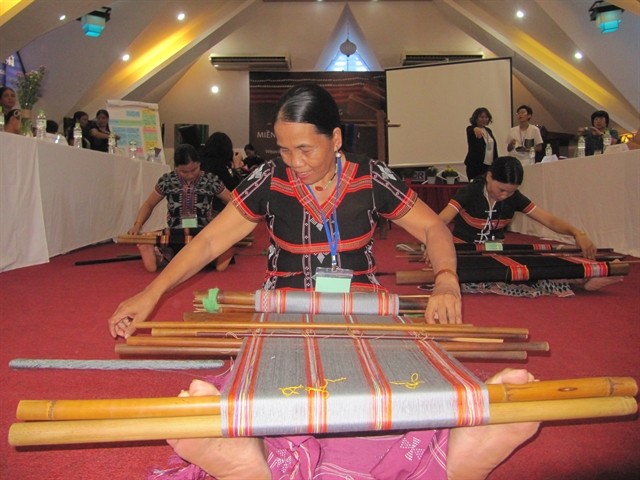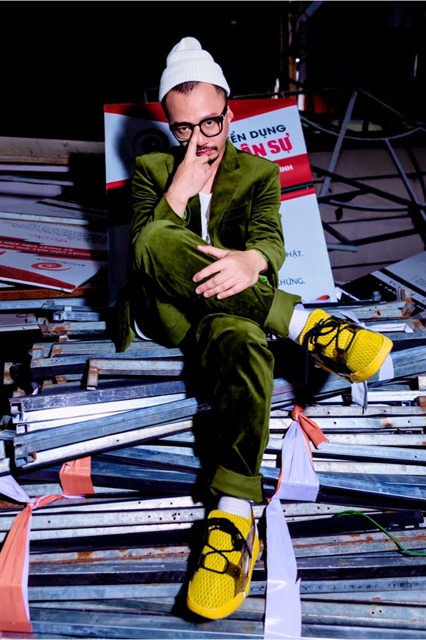 Inner Sanctum
Inner Sanctum

Hà Lê was already known in Việt Nam’s underground music scene as a leading rapper, dancer, and choreographer. He was at the centre of a degree of controversy last year, after revealing that his new project, “Trịnh Contemporary”, was to bring a breath of fresh air to the music of renowned Vietnamese composer Trịnh Công Sơn, with rap perhaps on the cards.

|
| LATE BLOOMER: Hà Lê made the transition from hip-hop dancer and choreographer to singer when he was 30 years old. Photo courtesy of the artist |
Hà Lê started his singing career later than most, when he was 30, though he was already known in Việt Nam’s underground music scene as a leading rapper, dancer, and choreographer. He was at the centre of a degree of controversy last year, after revealing that his new project, “Trịnh Contemporary”, was to bring a breath of fresh air to the music of renowned Vietnamese composer Trịnh Công Sơn, with rap perhaps on the cards. The singer spoke with Thúy Hằng about his journey from rapper to singer and what it’s like to cover an icon.
Inner Sanctum: You graduated in financial mathematics at NottinghamTrent University in the UK, so how did you come to pursue a career in the arts and not your field of study?
I had shown an aptitude for singing and dancing since I was a kid. I like the feeling of performing in front of others. Though they never said anything, I knew my parents wouldn’t help me make a career out of the arts.
In the UK, far from home, I could be myself. I studied hard, which pleased them, and also had more freedom to become involved with the arts, especially hip-hop dancing. The more I pursued this art form, the more I found that I couldn’t live without it. I decided that hip-hop was the path I wished to follow, but knew I had to try harder as I was late to the game. I was 20 at that time, while the hip-hop dancers I knew had started out when they were teenagers.
Inner Sanctum: Did your decision to pursue music create any tension in your family?
Actually, I was too scared to let my parents know initially. I kept it secret for a year before telling them about the profession I had chosen. They didn’t discourage me or oppose my decision, though, because they actually didn’t consider dancing to be a “job”.
Later on, with two friends, I formed a hip-hop dance group that then turned into a company specialising in teaching hip-hop and staging performances. In 2008, after six years of study and work in the UK, I returned to Việt Nam and continued to promote hip-hop in the country.
Though I have certain “achievements” in hip-hop under my belt, my parents didn’t believe in my career choice until about two years ago.
Inner Sanctum: You don’t seem to be satisfied with what you have achieved so far. You have now made a breakthrough decision to become a singer. Why make that transition?
We ran the dance company without any financial management skills, so after a few years it started posting losses. I then headed to Hồ Chí Minh City to seek other career opportunities. After witnessing its vibrant music scene, and knowing in my heart that I sang well, I found a new career direction. This was in 2014, when I was already 30 years old. I realised I wasn’t so young anymore and couldn’t waste time on anything else, so became devoted to my goal. It could be said this was my “start up” [laughs].
Having made that decision, there was some pressure on me. I wanted to be recognised as a singer and not a successful hip-hop dancer and choreographer. My greatest challenge has been to identify my own musical personality. I enrolled in an academy to “re-learn” everything related to music and singing and to find my own voice.
Inner Sanctum: How has Trịnh Công Sơn’s music influenced your life?
My grandmother and mother were fans of his, so I had heard his music throughout my childhood. I absorbed it into my veins and body. As I grew up, I found that many of his songs reflected my own personality and inner thoughts. Now, after experiencing the ups and downs of life, I can understand the philosophy hidden within his lyrics, which is what drove me to get the “Trịnh Contemporary” project off the ground. His music has undeniably changed the way I think and the way I judge everything that happens to me and around me.
I feel happy to have inherited his musical legacy. I only added a few elements to his songs to freshen them up. The more I work on this project, the closer the connection I feel between myself and the composer and his philosophy.

|
| ONE AND ONLY: Hà Lê is the only Vietnamese artist to have signed a contract with Sony Music Entertainment Vietnam. Photo courtesy of the artist |
Inner Sanctum: After your debut as a singer on a TV game show in 2017, where you surprised the audience by singing Trịnh Công Sơn’s Hạ Trắng (White Summer), you released a music video featuring another of his famous songs, Diễm Xưa (Diễm, My Cherished Old Flame). Those performances were a little controversial and many negative comments came your way. Do you still receive such comments?
Fortunately, people got to know more about me and listened to more of my music. People make all sorts of comments. Those that are encouraging and complimentary, I take on board, while those that are critical or disparaging I use as an anchor to keep my feet on the ground. Artists who only receive compliments can begin to have delusions about their ability and success.
Inner Sanctum: When you launched “Trịnh Contemporary”, you said the project would comprise different art forms such as music, cinematography, dance, performance art, and photography. What stage are you in now?
After releasing a debut album featuring seven of his iconic songs, I’m now producing music videos for them all. I already have three made. Our team is also working on producing the album in the vinyl format.
My plans also include a tour targeted at students in Hà Nội, HCM City, Huế, Quy Nhơn, and Đà Lạt. Why students? First, for some reason, they don’t have many opportunities to attend large concerts. Second, they need to be inspired by Sơn’s music, so it can be passed down through the generations. Third, I like performing for young people, because they are optimistic and enthusiastic. Sometimes I feel their positive energy being transmitted to me.
I’m also preparing a concert on my musical journey.
Inner Sanctum: You have said your dream is to see Vietnamese artists being recognised and honoured at major awards ceremonies around the world. Only then, you believe, will the world be exposed to and appreciate the beauty of Vietnamese music. What have you personally done for this dream to come true?
To move that dream towards reality, I signed a contract with Sony Music Entertainment Vietnam, a member of global Sony Music Entertainment (SME), which is one of the three largest record companies in the world. I am the only artist in Việt Nam SME has signed a contract with.
Alongside supporting me professionally, from producing to distribution, marketing, and communications, the contract also means my music has access to regional and global markets. I will also have the chance to work with international artists. In March, I joined 13 other singers from nine countries and territories in Asia to perform in a video featuring the song Forever Beautiful. Co-produced by SME in those countries and territories, the song was aimed at encouraging health workers during the COVID-19 pandemic.
Inner Sanctum: How did it feel to be a winner at Việt Nam Television’s recent VTV Awards?
The award was the first in my singing career. I was surprised to have won, to be honest. These awards, though, honour high-rating TV shows and popular MCs and other artists, so I need to work harder and be recognised in other professional awards. VNS




